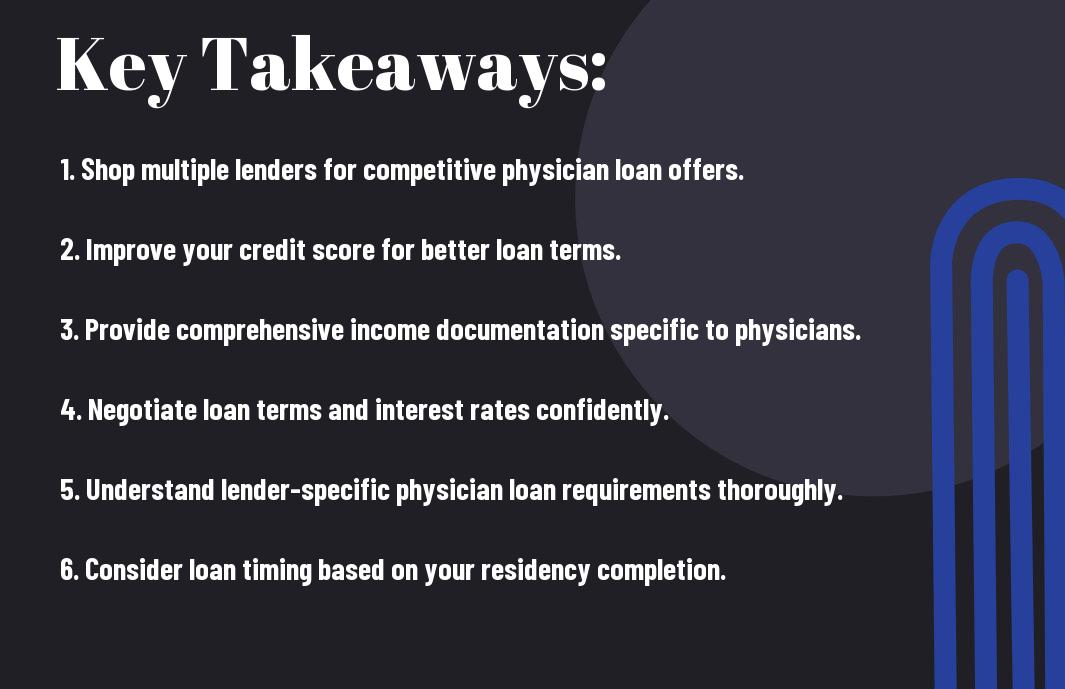Rates on physician loans can vary significantly based on several factors, making it crucial for you to navigate the process effectively. To help you secure the most favorable terms, this guide offers expert tips tailored specifically for your unique financial situation as a physician. By empowering you with the right knowledge and strategies, you can confidently approach lenders and negotiate a loan that best fits your needs, ensuring your hard work is financially rewarded.
Understanding Physician Loans
Before exploring into the intricacies of securing the best rates, it’s crucial to grasp what a physician loan entails. These specialized loans are designed specifically for medical professionals, offering features that help you secure financing even if you face unique financial situations related to your profession.
What is a Physician Loan?
Physician loans are tailored mortgage products that cater exclusively to doctors, residents, and fellows. They typically offer favorable terms and conditions to ease your entry into homeownership during or shortly after your medical training, recognizing that you may have lower incomes or substantial student debt.
Key Features of Physician Loans
Loans come with various benefits that make them appealing to medical professionals. Here are some significant features you should consider:
- No private mortgage insurance (PMI) required
- Higher loan limits compared to traditional mortgages
- 0% to low down payment options
- Flexible credit score requirements
- Deferred payments during residency
After reviewing these key features, you’ll better understand how they can support your journey toward homeownership.
Plus, understanding these features will empower you to leverage your financial position effectively. They distinguish physician loans from conventional lending options, providing you with greater flexibility and affordability:
- Specialized underwriting processes that consider future earning potential
- Ability to close without a significant down payment
- Loan forgiveness options available in some cases
- Competitive interest rates
After familiarizing yourself with these aspects, you’ll be well-equipped to navigate the physician loan landscape and secure the best rates available.
Assessing Your Financial Situation
Clearly, understanding your financial situation is an imperative step in securing the best rates on your physician loan. Before you begin the application process, gather information regarding your income, savings, debts, and credit score. This assessment will help you identify areas for improvement and ensure you present a strong financial profile to lenders, ultimately increasing your chances of obtaining favorable loan terms.
Credit Score Importance
On reviewing your financial profile, one of the most vital components to consider is your credit score. A high credit score demonstrates to lenders that you are a responsible borrower. By maintaining or improving your credit score before applying for a physician loan, you can position yourself for lower interest rates and better loan options.
Debt-to-Income Ratio Analysis
About your debt-to-income (DTI) ratio, this key metric represents the percentage of your monthly income that goes toward debt payments. Lenders use this ratio to evaluate your ability to manage monthly payments, and a lower DTI ratio typically leads to more favorable loan terms. Thus, ensuring your income significantly outweighs your debt obligations can improve your chances of securing the best rates.
And while assessing your DTI ratio, aim for a balance that showcases your financial stability. A DTI of 43% or lower is often preferred by lenders, but the lower, the better. Reducing any outstanding debts or increasing your income, whether through additional shifts or alternative revenue streams, can help strengthen your application. Consider revisiting your budget to identify areas where you can cut costs or to find opportunities to pay off high-interest debt, as this will not only improve your DTI but also enhance your overall financial standing.
Shopping for Lenders
Any time you’re seeking a physician loan, it’s imperative to shop around for lenders. Each lender may have different offerings and terms, so comparing options ensures you secure the most favorable deal. Take your time to research and consult multiple sources to find the best fit for your financial needs.
Comparing Interest Rates
Among the many factors influencing your decision, interest rates hold significant weight. To help you navigate this process, consider the following:
| Lender | Interest Rate |
|---|---|
| Lender A | 3.5% |
| Lender B | 3.75% |
| Lender C | 3.6% |
Evaluating Lender Reputation
Among the different lenders, their reputation matters greatly. Look for reviews, testimonials, and ratings that reflect their reliability and customer satisfaction. Engaging with others who have experience with specific lenders can offer insights you may not find online.
Even small differences in lender reputation can influence your overall experience. Check online platforms and forums to hear firsthand accounts from other physicians. Strong communication, transparency in terms, and a supportive approach to your unique circumstances are key indicators of a trustworthy lender.
Preparing Your Application
Your success in securing the best rates on a physician loan begins with thorough preparation of your application. This involves not only gathering necessary documents but also ensuring that the information you provide is accurate and complete. Taking the time to prepare can significantly enhance your chances of obtaining favorable terms and a smooth approval process.
Necessary Documentation
Before submitting your application, ensure you have all the necessary documentation in order. This typically includes your medical school transcripts, proof of residency or fellowship, tax returns, and employment contracts. Being organized and thorough in providing these documents can streamline the approval process and help you achieve better loan terms.
Common Application Mistakes
Across the physician loan application process, common mistakes can hinder your approval chances. Errors such as submitting incomplete documentation, providing outdated financial information, or failing to disclose debts can lead to unnecessary delays or denials. Avoid these pitfalls by double-checking everything before submission.
In fact, many applicants overlook minor details that can have a significant impact on their loan application. For example, miscalculating income or neglecting to update a change in employment status can raise red flags for lenders. Staying vigilant about the accuracy of your financial disclosures and ensuring all required documents are included in your application are critical steps in securing the best rates possible.
Negotiating Terms
For securing the best rates on your physician loan, negotiating terms is necessary. Engage with your lender on various aspects of the loan to ensure you receive favorable conditions that align with your financial goals. Don’t hesitate to ask about the flexibility of loan terms, interest rates, and any available benefits to help you maximize your investment.
Interest Rate Negotiation Strategies
Among the effective strategies for negotiating interest rates is to shop around and compare multiple lenders. Present your research and any competing offers to leverage better rates. Additionally, consider locking in rates, especially if you notice them fluctuating, as this can help protect you from rises in the market.
Loan Fees and Closing Costs
To gain a better understanding of your overall expenses, pay close attention to loan fees and closing costs. These additional charges can significantly impact the total amount you pay over the life of the loan, so it’s important to clarify all associated costs with your lender.
Plus, you should review the Loan Estimate document provided by your lender, which outlines all fees. Question any items that seem excessive or unclear, and don’t hesitate to negotiate these costs. Sometimes lenders will reduce fees to secure your business, leading to overall savings that contribute to your financial well-being.

Final Thoughts on Securing the Best Rate
Unlike traditional mortgages, physician loans often come with unique benefits tailored to your situation. It’s necessary to do your homework and shop around for the best rates. Engaging with various lenders, understanding your financial situation, and staying timely with your applications can significantly increase your chances of securing favorable terms. Your diligence now can lead to substantial savings over the life of your loan.
Long-term Financial Planning
Above all, effective long-term financial planning should align with your goals for homeownership and career trajectory. Assessing your future income potential and possible changes in your career can help you determine how much you can realistically afford. Managing your debt levels wisely and planning for potential investments will further empower you to negotiate better loan terms.
Importance of Timing
An understanding of market conditions and lender cycles can greatly influence your loan rate. If you’re able to time your loan acquisition during favorable economic conditions or when rates dip, you can lock in a lower rate. Staying informed about trends in the mortgage market can help you make critical decisions that benefit your financial future.
Understanding the significance of timing is vital in securing the best mortgage rates. Timing your application to coincide with favorable shifts in interest rates can lead to remarkable savings over the life of your loan. Keep an eye on economic indicators that signal trends, and consider locking in your rate when conditions are advantageous. This strategy can empower you to make an informed decision, ensuring your financial security and enhancing your home-buying experience.

To wrap up
Conclusively, securing the best rates on your physician loan involves careful planning and informed decision-making. Start by comparing multiple lenders and their offerings to identify the most favorable terms. Work on enhancing your credit score and consider negotiating rates based on your financial profile. Additionally, seeking guidance from financial advisors who specialize in loans for medical professionals can provide valuable insights. By taking these steps, you can position yourself to obtain a loan that aligns with your financial goals and supports your career as a physician.




